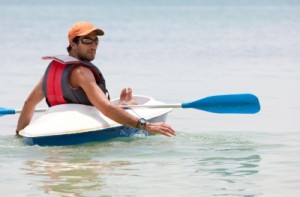 What is a kayak? The first kayak was made by Eskimo hunters in sub-Arctic regions of Asia, North America, and Greenland. It is a small and narrow, human-powered boat primarily designed to be manually propelled by means of a double blade paddle. The traditional kayak has a covered deck and one or more cockpits, each seating one paddler. Many kayaks are covered with what is called a spray deck that prevents the entry of water from waves or spray and makes it possible for skilled kayakers to roll the kayak without filling it with water or ejecting the paddler.
What is a kayak? The first kayak was made by Eskimo hunters in sub-Arctic regions of Asia, North America, and Greenland. It is a small and narrow, human-powered boat primarily designed to be manually propelled by means of a double blade paddle. The traditional kayak has a covered deck and one or more cockpits, each seating one paddler. Many kayaks are covered with what is called a spray deck that prevents the entry of water from waves or spray and makes it possible for skilled kayakers to roll the kayak without filling it with water or ejecting the paddler.
Some modern boats vary considerably from a traditional design but still claim the title ‘kayak’. Some have inflated air chambers surrounding the boat and the paddler sits on top of the boat. This is called a “sit-on-top” kayak. A single hull is replaced by twin hulls replacing paddles with other human powered propulsion methods, such as a foot-powered rotational propeller or flippers. Kayaks are also being sailed and propelled by small electric motors and outboard gas engines. This makes this water vehicle quite versatile.
As kayaking goes, the sport of kayaking can be broken to several different categories. For instance, recreational is for the casual paddler interested in recreational activities on a lake or flatwater stream. They actually constitute the largest segment of kayak sales. Recreational kayaks are characterized by having a larger cockpit opening for easy entry and exit and are known for being more stable. They are slower but lighter and easier to handle on the water. They are also less expensive which contributes to their popularity – affordability. They have limited cargo carrying capacity.
Another category of kayaks is the fishing kayak. They generally feature an inline outrigger system giving anglers a choice of three positions. They allow fishermen to track fish with less drag and water movement. Most of them are durable with the ability to withstand impact with rocks, boulders, and other obstacles.
Whitewater kayaking is the sport of paddling a kayak on a moving body of water, typically a whitewater river. Whitewater kayaking can range from active, moving water, to demanding, extreme whitewater.
Another category of kayak is the racing kayak. Characteristically, they are fast. There are several things that contribute to speed. You will often here about “hull speed” in relation to boat speed. This term is a misnomer in that it implies that there is a speed a hull will go. What it really indicates is the speed at which the hull starts to become rapidly more inefficient. This often means the boat is quite narrower in front of the cockpit for a clean start of the stroke. The cockpit may be long to permit the paddlers legs to move.
If your plans include shopping for a kayak in the future, there are things to consider before choosing which type will be most suitable for you and your family. Where will you go – lake, river, or stream? How far will you travel in your kayak? Will you paddle alone or with someone else? What is your skill level? One thing is certain; kayaks are an inexpensive and versatile mode of transportation for fun on the water.
Source: “Screen Name Required.” Kayaks: How to Choose”. Web. 09 Jan. 2013.
Follow Us: Facebook – Foursquare – Twitter – YouTube – LinkedIn
